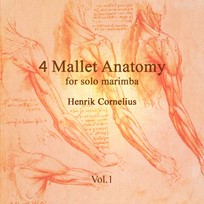
4 Mallet Anatomy
Composer: Henrik Cornelius
Instrument: Marimba
Level: Advanced
Published: 2018
Price: €25.00
Item details
-
Description +
-
On the journey to mastering your instrument you should never underestimate the need for comprehensive technical exercises. But do they have to be boring?
4 Mallet Anatomy is a collection of small compositions which are perfect both for playing in concerts and for daily practice. The series is aimed at both the professional looking to maintain his or her skills, and also the student who is cultivating them.
4 Mallet Anatomy is based on developing control of specific anatomical movements, ideally without compromising on natural melody and harmonization. These small works cannot in any way replace the laborious work of technical exercises, but they can be a supplement that makes it a little more fun perfecting the necessary motor skills.
Pronation Waltz and Supination Bagatelle both focus on the rotation of the wrist (pronation being the inward rotation and supination the outward rotation). In both works, almost anything apart from the notes is left to the musicians's own musical preferences. There are two reasons for this. Firstly, pace, dynamics and phrasing must fit the musician's technical level. Secondly, there must be room for renewed interpretation to create the energy for even more hours at the instrument. Pronation Waltz and Supination Bagatelle are musically connected and go well together.
Intrinsic Tune challenges the hand's inner muscles (the intrinsic muscle group), in the complex, fine-motor shifts between wide and narrow mallet intervals, using both independent and double vertical strokes. Be aware of the melody line in the 6/8 section, which changes between the soprano voice (mallet 4) and the tenor voice (mallet 2) even taking a single bar in the bass voice (mallet 1). A thorough warm up is recommended.
Ulnar & Radial Brainwash is a minimalist composition taking the sideward movement of the wrist to the extreme. Ulnar deviation is the bending of the wrist outwards to the little finger, or ulnar bone, side. Radial deviation is the bending of the wrist inwards to the thumb, or radial bone, side. Brainwash is self explanatory, especially if you choose to perform the optional repetitions.
Flexion Impression explores the lack of natural rebound from the bars of the marimba, forcing the player to create a spring-like bouncing in the wrist in order to perform the fast double and triple strokes.
-
-
Instrumentation +
-
Solo Marimba
-
-
About the composer +
-
Henrik Cornelius serves as Principal Timpani of the Sønderjyllands Symfoniorkester (South Denmark Philharmonic). He has a passion for playing virtuoso solo works for vibraphone and has co-edited an Edition Svitzer publication of Max Seide Leth's works and events. Henrik is also a dedicated chamber musician, organizer, teacher and lecturer. He received his training in percussion from The Royal Danish Conservatory of Music in Copenhagen.
-
-
Reviews +
-
Review (Percussive Notes, June 2020)
4 Mallet Anatomy is a collection of five short compositions, each geared toward different body motions involved while performing with four mallets. “Pronation Waltz” and “Supination Bagatelle” involve rotation of the wrist, while “Intrinsic Tune” combines lateral movement with double vertical motion. “Ulnar & Radial Brainwash” is in a hypnotic moto perpetuo style, and “Flexion Impression” involves double and triple strokes.
The compositions are somewhere in between etudes and pieces: the overall harmonic and melodic content is interesting, but the focus on a single technical element within each piece is a quality found in etudes more-so than music of the concert hall. Labels are the least important part of a musical composition; yet it is worth knowing that, while 4 Mallet Anatomy is not quite a book of etudes, neither is it a collection of five independent concert solos.
Where 4 Mallet Anatomy truly excels is in the sweet nature of the musical material. The composer has breathed a sweetness into the technical considerations. Any one of these would be appropriate for a recital, with “Intrinsic Tune” standing above the rest. “Pronation Waltz” and “Supination Bagatelle” are devoid of dynamics, encouraging performers to develop a personal sense of how to shape, phrase, and pace their performance.
Composer Henrik Cornelius provides a way to work on technique while keeping things interesting. He was quite successful; each piece is pleasing to listen to and provides a strong canvas on which to build or maintain four-mallet technique. This is a worthy collection, and perhaps the author will create more in the future.
—Jamie Wind Whitmarsh
-
-
Credits +
-
Front Cover graphics and layout: Gaia Rodrigues
Drawing: Pen and ink studies of the human arm, shoulder, and neck by Leonardo da Vinci, c1510
Engraving: Henrik Cornelius
Copyright © Edition SVITZER
www.editionsvitzer.com
-




